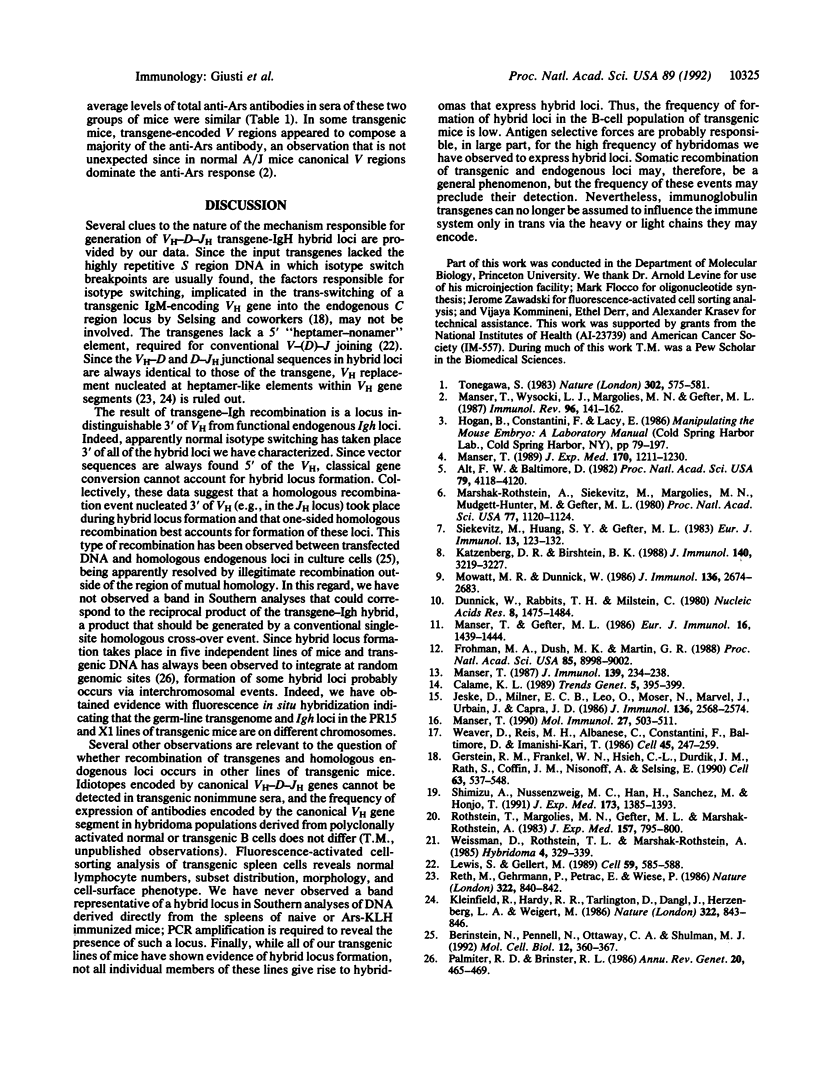Abstract
Transgenic lines of mice were derived by using plasmid constructs containing DNA encoding an antibody heavy chain variable-diversity-joining region (VH-D-JH) and various amounts of 5' and 3' flanking DNA but lacking any repetitive isotype switch (S) or constant (C) region DNA. Unexpectedly, many of the antibody VH regions expressed by B-cell hybridomas generated from immunized transgenic mice were found to be of transgenic origin. Further analyses showed that somatic events had generated hybrid genomic loci in the mice containing the transgenic VH-D-JH gene and plasmid sequences 5' of endogenous heavy chain C region genes. Thus, VH-D-JH transgenes lacking S and C region DNA can recombine with endogenous Igh DNA, leading to the expression of transgene-encoded antibody.
Full text
PDF




Images in this article
Selected References
These references are in PubMed. This may not be the complete list of references from this article.
- Alt F. W., Baltimore D. Joining of immunoglobulin heavy chain gene segments: implications from a chromosome with evidence of three D-JH fusions. Proc Natl Acad Sci U S A. 1982 Jul;79(13):4118–4122. doi: 10.1073/pnas.79.13.4118. [DOI] [PMC free article] [PubMed] [Google Scholar]
- Berinstein N., Pennell N., Ottaway C. A., Shulman M. J. Gene replacement with one-sided homologous recombination. Mol Cell Biol. 1992 Jan;12(1):360–367. doi: 10.1128/mcb.12.1.360. [DOI] [PMC free article] [PubMed] [Google Scholar]
- Calame K. L. Immunoglobulin gene transcription: molecular mechanisms. Trends Genet. 1989 Dec;5(12):395–399. doi: 10.1016/0168-9525(89)90197-2. [DOI] [PubMed] [Google Scholar]
- Dunnick W., Rabbitts T. H., Milstein C. A mouse immunoglobulin heavy chain deletion mutant: isolation of a cDNA clone and sequence analysis of the mRNA. Nucleic Acids Res. 1980 Apr 11;8(7):1475–1484. doi: 10.1093/nar/8.7.1475. [DOI] [PMC free article] [PubMed] [Google Scholar]
- Frohman M. A., Dush M. K., Martin G. R. Rapid production of full-length cDNAs from rare transcripts: amplification using a single gene-specific oligonucleotide primer. Proc Natl Acad Sci U S A. 1988 Dec;85(23):8998–9002. doi: 10.1073/pnas.85.23.8998. [DOI] [PMC free article] [PubMed] [Google Scholar]
- Gerstein R. M., Frankel W. N., Hsieh C. L., Durdik J. M., Rath S., Coffin J. M., Nisonoff A., Selsing E. Isotype switching of an immunoglobulin heavy chain transgene occurs by DNA recombination between different chromosomes. Cell. 1990 Nov 2;63(3):537–548. doi: 10.1016/0092-8674(90)90450-s. [DOI] [PubMed] [Google Scholar]
- Jeske D., Milner E. C., Leo O., Moser M., Marvel J., Urbain J., Capra J. D. Molecular mapping of idiotopes of anti-arsonate antibodies. J Immunol. 1986 Apr 1;136(7):2568–2574. [PubMed] [Google Scholar]
- Katzenberg D. R., Birshtein B. K. Sites of switch recombination in IgG2b- and IgG2a-producing hybridomas. J Immunol. 1988 May 1;140(9):3219–3227. [PubMed] [Google Scholar]
- Kleinfield R., Hardy R. R., Tarlinton D., Dangl J., Herzenberg L. A., Weigert M. Recombination between an expressed immunoglobulin heavy-chain gene and a germline variable gene segment in a Ly 1+ B-cell lymphoma. 1986 Aug 28-Sep 3Nature. 322(6082):843–846. doi: 10.1038/322843a0. [DOI] [PubMed] [Google Scholar]
- Lewis S., Gellert M. The mechanism of antigen receptor gene assembly. Cell. 1989 Nov 17;59(4):585–588. doi: 10.1016/0092-8674(89)90002-0. [DOI] [PubMed] [Google Scholar]
- Manser T. Evolution of antibody structure during the immune response. The differentiative potential of a single B lymphocyte. J Exp Med. 1989 Oct 1;170(4):1211–1230. doi: 10.1084/jem.170.4.1211. [DOI] [PMC free article] [PubMed] [Google Scholar]
- Manser T., Gefter M. L. The molecular evolution of the immune response: idiotope-specific suppression indicates that B cells express germ-line-encoded V genes prior to antigenic stimulation. Eur J Immunol. 1986 Nov;16(11):1439–1444. doi: 10.1002/eji.1830161120. [DOI] [PubMed] [Google Scholar]
- Manser T. Limits on heavy chain junctional diversity contribute to the recurrence of an antibody variable region. Mol Immunol. 1990 Jun;27(6):503–511. doi: 10.1016/0161-5890(90)90069-c. [DOI] [PubMed] [Google Scholar]
- Manser T. Mitogen-driven B cell proliferation and differentiation are not accompanied by hypermutation of immunoglobulin variable region genes. J Immunol. 1987 Jul 1;139(1):234–238. [PubMed] [Google Scholar]
- Manser T., Wysocki L. J., Margolies M. N., Gefter M. L. Evolution of antibody variable region structure during the immune response. Immunol Rev. 1987 Apr;96:141–162. doi: 10.1111/j.1600-065x.1987.tb00513.x. [DOI] [PubMed] [Google Scholar]
- Marshak-Rothstein A., Siekevitz M., Margolies M. N., Mudgett-Hunter M., Gefter M. L. Hybridoma proteins expressing the predominant idiotype of the antiazophenylarsonate response of A/J mice. Proc Natl Acad Sci U S A. 1980 Feb;77(2):1120–1124. doi: 10.1073/pnas.77.2.1120. [DOI] [PMC free article] [PubMed] [Google Scholar]
- Mowatt M. R., Dunnick W. A. DNA sequence of the murine gamma 1 switch segment reveals novel structural elements. J Immunol. 1986 Apr 1;136(7):2674–2683. [PubMed] [Google Scholar]
- Palmiter R. D., Brinster R. L. Germ-line transformation of mice. Annu Rev Genet. 1986;20:465–499. doi: 10.1146/annurev.ge.20.120186.002341. [DOI] [PMC free article] [PubMed] [Google Scholar]
- Reth M., Gehrmann P., Petrac E., Wiese P. A novel VH to VHDJH joining mechanism in heavy-chain-negative (null) pre-B cells results in heavy-chain production. 1986 Aug 28-Sep 3Nature. 322(6082):840–842. doi: 10.1038/322840a0. [DOI] [PubMed] [Google Scholar]
- Rothstein T. L., Margolies M. N., Gefter M. L., Marshak-Rothstein A. Fine specificity of idiotope suppression in the A/J anti-azophenylarsonate response. J Exp Med. 1983 Feb 1;157(2):795–800. doi: 10.1084/jem.157.2.795. [DOI] [PMC free article] [PubMed] [Google Scholar]
- Shimizu A., Nussenzweig M. C., Han H., Sanchez M., Honjo T. Trans-splicing as a possible molecular mechanism for the multiple isotype expression of the immunoglobulin gene. J Exp Med. 1991 Jun 1;173(6):1385–1393. doi: 10.1084/jem.173.6.1385. [DOI] [PMC free article] [PubMed] [Google Scholar]
- Siekevitz M., Huang S. Y., Gefter M. L. The genetic basis of antibody production: a single heavy chain variable region gene encodes all molecules bearing the dominant anti-arsonate idiotype in the strain A mouse. Eur J Immunol. 1983 Feb;13(2):123–132. doi: 10.1002/eji.1830130207. [DOI] [PubMed] [Google Scholar]
- Tonegawa S. Somatic generation of antibody diversity. Nature. 1983 Apr 14;302(5909):575–581. doi: 10.1038/302575a0. [DOI] [PubMed] [Google Scholar]
- Weaver D., Reis M. H., Albanese C., Costantini F., Baltimore D., Imanishi-Kari T. Altered repertoire of endogenous immunoglobulin gene expression in transgenic mice containing a rearranged mu heavy chain gene. Cell. 1986 Apr 25;45(2):247–259. doi: 10.1016/0092-8674(86)90389-2. [DOI] [PubMed] [Google Scholar]
- Weissman D., Rothstein T. L., Marshak-Rothstein A. A rapid method for comparing monoclonal antibodies by limited proteolysis and electrophoresis. Hybridoma. 1985 Winter;4(4):329–339. doi: 10.1089/hyb.1985.4.329. [DOI] [PubMed] [Google Scholar]






